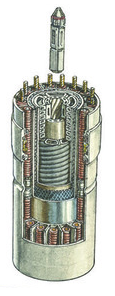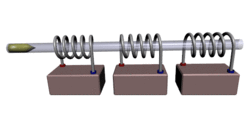User:BaconShelf/Sandbox5
From Halopedia, the Halo wiki

The magnetic accelerator cannon[1], also referred to as a mass accelerator cannon[2] or MAC, is a type of starship-mounted weapon system employed by humanity, primarily the spacecraft of the United Nations Space Command. MACs are coilguns used in military applications, though similar technology can be used in civilian mass drivers for industrial use.
Overview
MACs are fitted as a standard armament on most UNSC Navy vessels, ranging from small Gladius-class corvettes to Marathon-class heavy cruisers and even carriers or refit civilian ships such as the Phoenix-class colony ship. With a handful of exceptions, MACs are typically spinally-mounted, meaning that the entire ship is built around the gun, with the cannon running a significant portion of the length of the ship's stern. However, the technology is not exclusively used in spinally-mounted MAC guns, with naval autocannons (themselves sometimes referred to as "MiniMACs")[1] and even ground-based weapons such as the M68 Gauss cannon and M99 Stanchion operating on the same principle.[2]
Operation

MACs operate on the basis of a coilgun. When firing, a series of stacked asynchronous linear induction motors are sequentially activated, propelling a projectile with vast amounts of kinetic energy.[1] The construction of the weapon takes the form of a series of coiled conducting wires (or solenoids). When a solenoid is activated, the projectile is attracted to the coil. As the projectile reaches the coil, a second coil is activated, attracting the projectile further down the barrel of the gun. This process is repeated as the projectile travels the length of the gun, with each successive solenoid accelerating the projectile to higher and higher velocities. As such, the longer a MAC's length is, the faster the muzzle velocity of the fired projectile.
This process differs from that of a railgun - a similar weapon system which feeds electrical current through a projectile to accelerate it along two conducting rails.
To fire a MAC, UNSC ships must draw power from the fusion reactor into a series of capacitors, storing the generated energy for firing. As such, charging the MAC draws power away from other sub-systems such as engines. As such, a MAC can be pre-charged and fired when ready, though at the cost of power to the aforementioned systems. Without the charge being maintained, the charge level does deteriorate. However, MACs can be fired at lower charge levels than 100%[3] though likely to lesser maximum velocity. Likewise, firing the weapon at lower charge rates would also allow the weapon to fire more often, if needed.
Ammunition
MACs are capable of firing a wide array of munitions, depending on bore and model. Some MAC rounds are extremely dense and constructed of ferric tungsten[4], noted by Captain Wallace of the frigate UNSC Commonwealth as a "heavy round".[5] In the case of the MACs fitted onto the refit-colony ship UNSC Spirit of Fire, the rounds fired from its MACs are "ultra-light" or consist of depleted uranium slugs.[6] Other munitions that can be fired from MACs include semi-autonomous drone missiles[7] and for the larger 27 metre guns of UNSC Infinity, even include cargo pods and small spacecraft.[8] A special kind of MAC round fired by the refit-UNSC Pillar of Autumn was composed of a ferrous core and an outer layer of tungsten carbide, which allows the round to splinter on impact with an enemy vessel similarly to the shredder rounds fired by an assault rifle.[9]
Due to this variation, the masses, velocities and sizes of MAC projectiles can very, ranging from 10 metre-long, 160 ton models fired by frigates and cruisers[2], to 600 ton depleted uranium models fired by Paris-class heavy frigates[10] up to 3,000 ton projectiles accelerated to "point four-tenths" of the speed of light by the orbital defense platforms above Reach.[11] The MACs of UNSC Infinity are additionally capable of firing various "sub-caliber" munitions for its massive twenty-seven metre bore, alongside some of the special types mentioned prior.Template:Ref/
Types of MAC
Light MACs
Heavy MACs
Superheavy MACs
Sources
- ^ a b c Halo: Warfleet - Glossary, page 90-92
- ^ a b c Halo: Contact Harvest, chapter 7
- ^ Halo: The Fall of Reach, chapter 17
- ^ Halo: The Essential Visual Guide, page 114
- ^ Halo: The Fall of Reach, chapter 12
- ^ Halo Wars Manual, page 24
- ^ Halo: Warfleet - Destroyers, page 32-33
- ^ Halo: Warfleet - Infinity, page 42-43
- ^ Halo: The Fall of Reach, chapter 29
- ^ Halo: First Strike, chapter 29
- ^ Halo: The Fall of Reach, chapter 31
